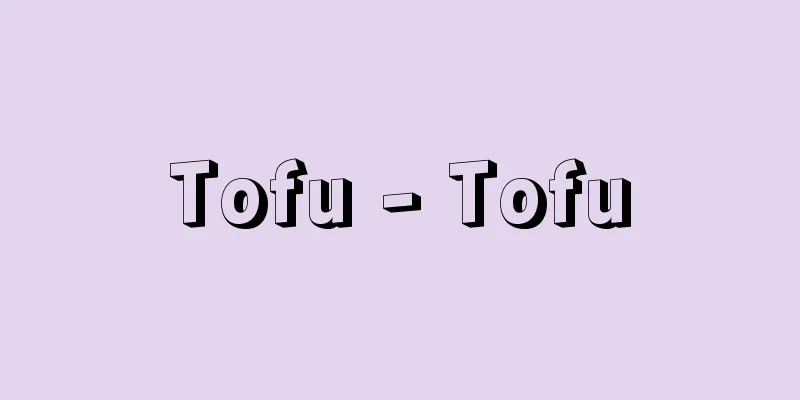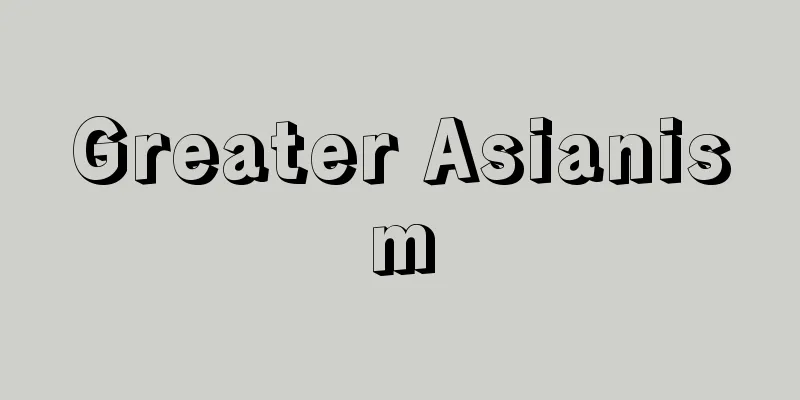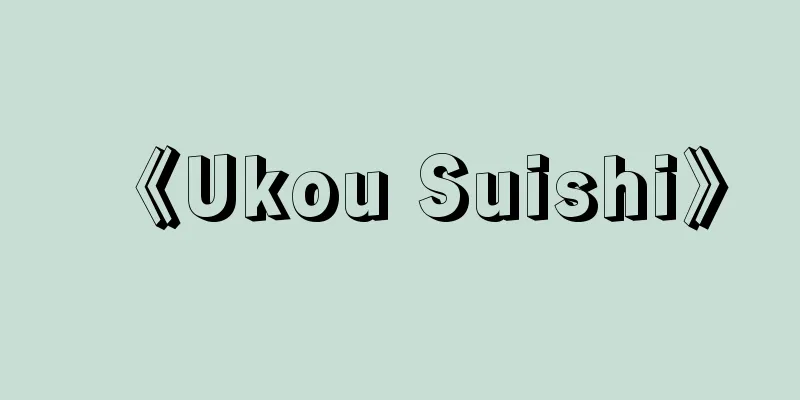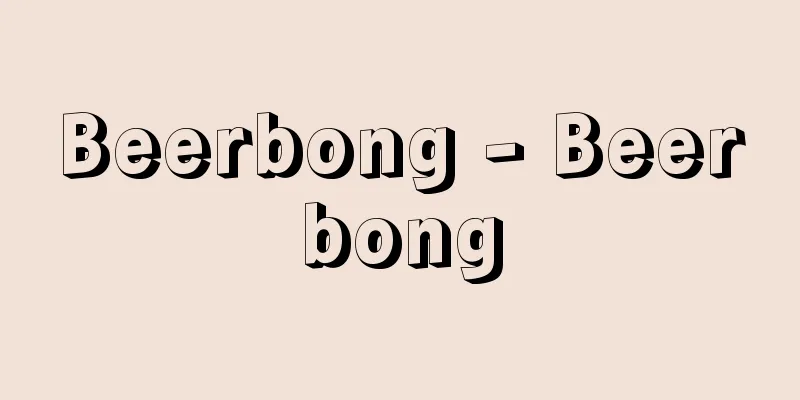Tofu - Tofu

|
A type of soybean processed food. Soybeans are soaked in water, crushed, boiled, strained, and then a coagulant is added to the soy milk to solidify it. It has a smooth texture and is easy to eat because the hard parts of the soybeans have been removed. It also has a light flavor, making it easy to use in a variety of dishes. [Tomomi Kono and Yonago Yamaguchi] historyIt is said that tofu was invented by Liu An (reigned?-122 B.C.), King of Huainan, the grandson of Emperor Gaozu of the Former Han Dynasty in China, and is also known by the nickname "Huainan". Its ingredients include black beans, yellow beans, white beans, mud beans, peas, and mung beans (Honzo Gangmu). However, it is believed to have actually started in the Tang Dynasty (618-907), and it is unclear when it was introduced to Japan. Records from the Heian period show that "Tang symbols" were offered to Kasuga Taisha Shrine. It seems that it became widespread after the Muromachi period. Tofu jelly and snow linseed appear as dishes served at Zen temples in the Teikin Orai (late Northern and Southern Courts to early Muromachi period). Yukirin-na means "kirazu" and was also written as yukihana-na (okara). Tofu was also called "kabe" (wall), "okabe" (shirokabe), "shiromono" (white wall), and other words in ladies' language. This is because tofu resembles a white wall in color and shape. In the Edo period, many dishes were introduced in "Ryori Monogatari" (1643) and "Tofu Hyakuchin" (1782). Tofu was a specialty of Nara and Uji in ancient times, but in the Edo period, famous shops appeared such as Gion tofu (dengaku) in Kyoto, Yudofu at Nanzenji Temple, and Sasa no Yuki (Yudofu) in Edo. Although the shape of tofu remains almost the same, various ingredients have been added, and many different types are available. [Tomomi Kono and Yonago Yamaguchi] kindsThe type of tofu that has been produced for the longest time is regular tofu, also known as goshi, but there are also silken tofu, soft tofu, seasoned tofu, filled tofu (bag tofu), and processed products such as grilled tofu, fried tofu (thin tofu), raw tofu (thick tofu), frozen tofu (frozen tofu), and ganmodoki (gangi).In addition, products made from ingredients other than soybeans are given names such as sesame tofu, peanut tofu (called jimami tofu in Okinawa), and egg tofu because they have the shape of tofu. [Tomomi Kono and Yonago Yamaguchi] Manufacturing methodSoybeans are soaked in water to soften them, and then ground in a grinder (previously called a stone mill) while water is added. This is called go, and more water is added to the go, and it is either boiled in a kettle or heated by blowing in steam. Heating removes the soybeans' grassy smell and the proteins dissolve into the liquid. Next, it is placed in a cloth bag, squeezed, and filtered, and then separated into soy milk and okara. When the soy milk has cooled to around 70°C, a coagulant is added. The method of adding the coagulant and the method of solidifying vary depending on the type of tofu. In the past, natural bittern was used as a coagulant, but nowadays, various other agents are added, such as artificial bittern, calcium sulfate, calcium carbonate, calcium chloride, and glucono-delta-lactone. To make cotton strained tofu, a coagulant is added when the soy milk has cooled somewhat to about 70°C. When the coagulant is added, the proteins in the soy milk begin to solidify, so the mixture is left to stand for a while, and then the lumpy coagulated material is poured into a box. This box has small holes on all four sides and is lined with cotton cloth. Excess water is filtered through the cotton cloth and drains out through the holes. A lid is placed on top of the molding box, and a weight is placed on top to drain the water. Once the tofu has solidified sufficiently, the box is placed in water, the tofu is removed, and it is left to soak in water for a while. The excess coagulant dissolves, improving the flavor. The tofu is then cut into appropriate pieces to prepare the product, with one block of tofu usually weighing 300 grams. About 4 to 5 kilograms of tofu can be produced from 1 kilogram of soybeans. It is called "cotton strained tofu" or "cotton tofu" because it is strained through cotton cloth when it is set in the mold box. There are holes here and there on the cut surface, and the texture is a little rough. Another characteristic is that the grain of the cloth from when it was strained is still visible on the tofu. Kinuso tofu is made by solidifying soy milk without draining it like cotton tofu. Its name comes from the fact that it is softer and contains more water than cotton tofu, and it is not strained through silk cloth. Kinuso tofu is made with slightly thicker soy milk. A mold box without holes is used. The coagulant is dissolved in advance and placed in the mold box, and hot soy milk is poured in and left to coagulate. It has a smooth surface and a good texture, but it is soft and difficult to handle. Soft tofu and filled tofu are made by mixing soy milk with a coagulant, putting it in a certain packaged mold, soaking it in boiling water at about 90°C for about 40 minutes to coagulate it, and cooling it in a water tank. Other types include Okinawa tofu, which is made in the Chinese style, and kumiage tofu, which is not drained thoroughly. Yaki tofu is made by grilling cotton tofu and browning it, giving it a browned color and a grilled aroma (nowadays it is done with a burner). It is often used in hotpot dishes as it does not crumble easily. Fried tofu is generally made by freezing tofu that has been cut thinly, and thickly sliced tofu, which is called namaage (atsuage). Frozen tofu is made by freezing firm tofu, allowing the ice crystals to grow large, then melting it in hot water and drying it. Ganmodoki is made by crumbling tofu and mixing it with burdock, carrots, sesame seeds, kelp, hemp seeds, etc., then deep frying it. [Tomomi Kono and Yonago Yamaguchi] nutritionTofu is a food rich in soy protein, but there are differences in the amount of protein between firm tofu, silken tofu, soft tofu, and packed tofu. The firmer the firm the tofu, the more protein it contains. Among the components of soy milk, water-soluble vitamins tend to leach out along with the water in firm tofu, but there is no leaching of vitamins in silken tofu, which solidifies the entire soy milk. [Tomomi Kono and Yonago Yamaguchi] Soybeans and their Processing 1, by Watanabe Atsuji, Saio Kyoko, and Hashizume Kazumune (1987, Kenpakusha) ▽ Watanabe Atsuji, supervised, The Easy Science of Tofu, revised edition (1996, Food Journal) ▽ Fukuda Hiroshi, Sugimoto Nobuko, and Matsufuji Shohei, Tofu 100 Delicacies (1998, Shinchosha) ▽ Nito Hitoshi, Food Processing Series 4: Tofu - The Secret to Making and Selling Delicious Tofu (2000, Rural Culture Association) ▽ Aspect, editor, Treasured Traditional Foods 3: Tofu (2000) ▽ Morii Genichi, The Way of Tofu (2004, Shinchosha) ▽ Soeda Takahiko, Japanese Cotton Tofu (2004, Saiwai Shobo) [Reference] | |©Shogakukan "> Firm tofu ©Shogakukan "> Silken tofu ©Shogakukan "> Grilled tofu When simply referring to fried tofu, it often refers to thin fried tofu. It is also called inariage. ©Shogakukan "> Deep-fried tofu (thinly fried) ©Shogakukan "> Deep-fried tofu (thick fried tofu) In addition to freeze-dried tofu, koji tofu, and frozen tofu, it is also called chihaya tofu, ren tofu, and one-night frozen tofu (one-night tofu) . Frozen tofu Also called Unohana or Yukihana ©Shogakukan "> Okara Tofu shop. "Shokuninzukushi Ekotoba" (Illustrated Tales of Artisans), third scroll (part) The original illustration is by Kuwagata Keisai (Masami Kitao), with a legend by Tegara Okamochi (Kizo Hoseido), owned by the National Diet Library . Tofu shop A tofu teahouse in Gion, Kyoto, during the Edo period. People are busy cutting tofu, skewering it and grilling it, and carrying it around. The "Fuchiya" written on the lantern is thought to refer to Fujiya, which, along with Nakamuraya, was known as a two-storey teahouse. Main volume, published in 1782 (Tenmei 2), held at the National Diet Library . "Tofu Hyakuten" Source: Shogakukan Encyclopedia Nipponica About Encyclopedia Nipponica Information | Legend |
|
大豆加工食品の一つ。大豆を水に浸してひきつぶし、煮て漉(こ)した豆乳に凝固剤を加えて固める。口あたりがよく、大豆の堅い部分が除かれているので食べやすい。また淡泊な風味で各種料理に応用しやすい。 [河野友美・山口米子] 歴史中国前漢の高祖の孫、淮南(わいなん)王劉安(りゅうあん)(在位?~前122)が発明したという伝承があり、豆腐の異称を「淮南」ともいう。その原料として、黒豆、黄豆、白豆、泥豆、豌豆(えんどう)、緑豆があげられている(『本草(ほんぞう)綱目』)。しかし、実際は唐代(618~907)に始まったとみられ、日本へ渡来した時期は不明で、平安時代の記録に「唐符」が春日(かすが)大社への供物として残されている。一般に広まったのは室町時代以降のようである。『庭訓往来(ていきんおうらい)』(南北朝後期~室町前期)には、禅院の料理として豆腐羹(かん)、雪林菜(せつりんさい)がみえる。雪林菜は「きらず」のことで雪花菜(おから)とも書かれた。豆腐のことを女房詞(にょうぼうことば)で「かべ」「おかべ」「しらかべ」「しろ物」などともいった。色や形が白壁に似ているためである。江戸時代には『料理物語』(1643)や『豆腐百珍』(1782)に数多くの料理が紹介されている。 豆腐は、古くは奈良や宇治(うじ)の名物であったが、江戸時代には、京都の祇園(ぎおん)豆腐(田楽(でんがく))、南禅寺(なんぜんじ)の湯豆腐、江戸の笹(ささ)の雪(湯豆腐)など名代の店も現れた。 豆腐は、形こそほとんど変わらないが、材料などにくふうが加えられ、かなり多くの種類ができている。 [河野友美・山口米子] 種類豆腐のなかで、もっとも古くからつくられていたのが木綿漉(ご)しとよばれる普通豆腐で、このほか絹漉し豆腐、ソフト豆腐、味つけ豆腐、充填(じゅうてん)豆腐(袋豆腐)、加工品としては、焼き豆腐、油揚げ(薄揚げ)、生(なま)揚げ(厚揚げ)、凍(こお)り豆腐(凍(しみ)豆腐)、がんもどき(雁擬)などがある。また、大豆以外のものを原料としたものでも豆腐の形状をしているところから、ごま豆腐、落花生(らっかせい)豆腐(沖縄ではジーマミ豆腐)、卵豆腐などの名前がつけられている。 [河野友美・山口米子] 製法水に浸(つ)けて柔らかくした大豆を、水を加えながら粉砕機(以前は石臼(いしうす))ですりつぶす。これを呉(ご)といい、呉にさらに水を加えて釜(かま)で煮て沸騰させるか蒸気を吹き込んで加熱する。加熱により大豆の青臭みがとれ、タンパク質も液中に溶け出す。次にこれを布袋に入れて絞って濾過(ろか)し、豆乳とおからに分ける。豆乳が70℃くらいに冷めたところで、凝固剤を加える。各豆腐により凝固剤の加え方や固め方が異なる。凝固剤としては、天然にがりが以前使用されていたが、現在は、このほか人工にがり、硫酸カルシウム、炭酸カルシウム、塩化カルシウム、グルコノデルタラクトンなど各種のものが加えられる。 木綿漉し豆腐の作り方は、豆乳がいくぶん冷めて70℃ぐらいになったころに凝固剤を入れる。凝固剤を加えると、豆乳中のタンパク質が固まってくるので、そのまましばらく静置したあと、もろもろした状態の凝固物を箱に流し込む。この箱は四方に小穴をあけたもので木綿布を敷いてある。余分の水分は、木綿布で漉され、小穴から流れ出る。型箱の上には落し蓋(ぶた)をして、重石(おもし)をのせ、水けをきる。豆腐が十分固まったら、箱のまま水に入れて豆腐を抜き出し、しばらく水に浸す。余分の凝固剤が溶け出し、味がよくなる。適当に切って製品とするが、普通、豆腐1丁は300グラムが標準である。大豆1キログラムからは約4~5キログラムの豆腐がとれる。型箱で固めるとき木綿布で漉すので、木綿漉し、または木綿豆腐という。切り口の面のところどころに穴がみられ、食感は少し粗い。また、漉したときの布目が豆腐についているのも特徴である。 絹漉し豆腐は、木綿豆腐のように水きりをせず、豆乳全体を固めたものである。木綿豆腐に比べ水分が多く柔らかなところからついた名称で、絹布で漉すわけではない。絹漉し豆腐は豆乳をいくぶん濃いめにつくる。型箱は穴のないものを用いる。凝固剤をあらかじめ溶いて型箱に入れ、その中に熱い豆乳を流し込み、そのまま静置して凝固させる。表面が滑らかで舌ざわりはよいが、柔らかいので取扱いがむずかしい。ソフト豆腐、充填豆腐は、豆乳に凝固剤を混ぜ、一定の包装型に入れてつくり、90℃ぐらいの熱湯中に40分ほど浸して凝固させ、水槽で冷却する。そのほか、中国式の作り方をする沖縄豆腐、十分な水切りをしないくみ上げ豆腐などがある。焼き豆腐は、木綿豆腐を焼いて焦げ目をつけたもので、焼き色と、焼いた香りがつく(現在はバーナーで焦げ目をつける)。くずれにくくなるので、鍋物(なべもの)などによく使われる。揚げ豆腐は、豆腐を薄く切ったものを一般に油揚げ(薄揚げ)といい、厚切りを生揚げ(厚揚げ)という。凍り豆腐の製法は、固めにつくった豆腐を冷凍し、氷の結晶を大きく成長させたのち、湯で溶かして乾燥させる。がんもどきは、豆腐をくずして、ゴボウ、ニンジン、ゴマ、昆布、アサの実などを混ぜて油で揚げたもの。 [河野友美・山口米子] 栄養豆腐は大豆タンパク質を豊富に含む食品であるが、木綿豆腐と絹漉し豆腐、ソフト豆腐、充填豆腐では、タンパク質の量に差がある。よく締まっている木綿豆腐ほどタンパク質が多い。豆乳の成分中、木綿豆腐では水とともに水溶性ビタミンが溶出しやすいが、豆乳全体を固める絹漉し豆腐のほうは、ビタミンの溶出はない。 [河野友美・山口米子] 『渡辺篤二・斎尾恭子・橋詰和宗著『大豆とその加工 1』(1987・建帛社)』▽『渡辺篤二監修『やさしい豆腐の科学』改訂版(1996・フードジャーナル社)』▽『福田浩・杉本伸子・松藤庄平著『豆腐百珍』(1998・新潮社)』▽『仁藤斉著『食品加工シリーズ4 豆腐――おいしいつくり方と売り方の極意』(2000・農山漁村文化協会)』▽『アスペクト編・刊『至宝の伝統食3 豆腐』(2000)』▽『森井源一著『豆腐道』(2004・新潮社)』▽『添田孝彦著『日本のもめん豆腐』(2004・幸書房)』 [参照項目] | |©Shogakukan"> 木綿豆腐 ©Shogakukan"> 絹漉し豆腐 ©Shogakukan"> 焼き豆腐 単に油揚げといったときには、薄揚げをさすことが多い。いなり揚げともいう©Shogakukan"> 油揚げ(薄揚げ) ©Shogakukan"> 生揚げ(厚揚げ) 高野豆腐、凝豆腐、凍豆腐のほか、ちはや豆腐、連豆腐、一夜凍り豆腐(一夜豆腐)ともいう©Shogakukan"> 凍り豆腐 卯の花、雪花菜ともいう©Shogakukan"> おから 豆腐屋。『職人尽絵詞』 第3軸(部分) 原図は、鍬形蕙斎(北尾政美)画、手柄岡持(朋誠堂喜三二)詞書国立国会図書館所蔵"> 豆腐屋 江戸時代の京都祇園の豆腐茶屋。豆腐を切る者、串に刺して焼く者、運ぶ者が忙しく立ち働く。提灯に書かれた「ふちや」は、中村屋とともに二軒茶屋と並称された藤屋のことと思われる。正編 1782年(天明2)刊国立国会図書館所蔵"> 『豆腐百珍』 出典 小学館 日本大百科全書(ニッポニカ)日本大百科全書(ニッポニカ)について 情報 | 凡例 |
>>: Crimes related to theft, etc.
Recommend
Katsuren Peninsula - Katsuren Peninsula
Please see the "Yokatsu Peninsula" page...
Pterodroma hypoleuca
…[Hiroshi Hasegawa]. … *Some of the terminology t...
Field crops - Field cultivation
〘 noun 〙 The act of cultivating fields and produci...
Prejudice
Prejudice is a concept that refers to a fixed view...
Kermenchik
…In the 4th and 3rd centuries BC, it flourished a...
Sapporo Winter Olympic Games - Sapporo Winter Olympic Games
The 11th Winter Olympic Games were held in Sapporo...
Chahamana (English spelling)
…A dynasty in the Rajasthan region of India, coun...
Oshioyake - Oshioyake
…In Kyoto, fires broke out soon after the capital...
Tea ceremony utensils
Tools necessary for the tea ceremony. They are bro...
Isotopes - Douwei
Nuclear species with the same number of protons i...
jester
…The word fool originates from the Latin follis (...
Kiyomoto Eijudayu
…(2) The second (1802-1855, Kyowa 2-Ansei 2) was ...
Theory of the divine rights of kings
A political ideology that the king's right to...
Allometry
…It is a term used to describe the change in form...
Chemical prevention - KAGAKUYOBO
…However, chemotherapy is now being attempted for...









